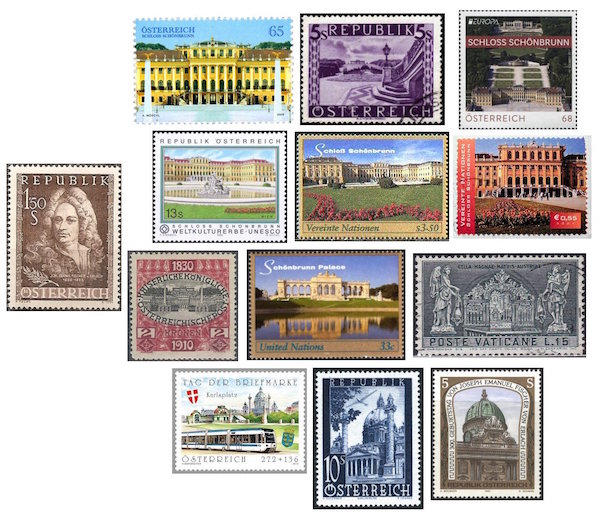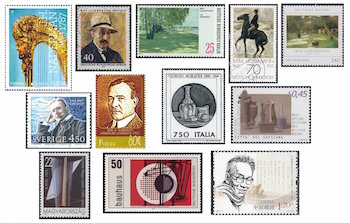The Arts on Stamps of the World — July 20
An Arts Fuse regular feature: the arts on stamps of the world.

By Doug Briscoe
It’s the birthday of the great medieval Italian poet Francesco Petrarca (July 20, 1304 – July 19, 1374), whose sonnets and other works found musical expression as early as the Renaissance, with settings by such masters as Monteverdi, Dufay and Palestrina (who both set the same sonnet, #366), Lassus, Luca Marenzio, Andrea Gabrieli, and Willaert. It may surprise you (as it did me) to learn that Haydn wrote music to Petrarch—the Sonnet #28, “Solo et pensoso”— as a concert aria in 1798! Otherwise, the 18th and 19th centuries seem largely to have eschewed the Italian master, although there are numerous settings by Johann Friedrich Reichardt and one by Glazunov. Probably the most famous Petrarch songs are the three by Franz Liszt, which he also adapted as solo piano works for the second volume of his Années de Pélèrinage. One of those sonnets, #104, “Pace non trovo”, was also set by Peter Cornelius, Rheinberger, and Schubert (!), who wrote three songs to Petrarch in translations by August Wilhelm von Schlegel in 1818. The 20th century found many more advocates for Petrarch, including Castelnuovo-Tedesco, Pizzetti, Pfitzner, Norman Dello Joio, Dominick Argento, and the Australian Colin Brumby. Schoenberg used Petrarch’s words in a number of pieces, perhaps most famously in the middle movement of his Serenade.

The name may not be familiar, but Johann Bernhard Fischer von Erlach (baptized 20 July 1656, died 5 April 1723) was an architect of great importance. He built Schönbruun Palace, for starters, but more to the point, his work had a deep and lasting influence throughout the Habsburg Empire. Fischer was born in Graz to a father who worked as sculptor and artisan for the Princes of Eggenberg. Having learned what he could from dad, he went at age sixteen to Rome and remained in Italy for about fifteen years, also serving the Spanish viceroy in Naples. His reputation followed him back to Austria, where his talents were much in demand. Emperor Joseph I raised him to the nobility, as Fischer von Erlach. His projects from this period include the Winter Palace for Prince Eugene of Savoy and much work in Salzburg, notably the Holy Trinity Church (Dreifaltigkeitskirche, 1694–1702). He also designed the high altar, seen on a stamp from Vatican City, the gray one, for the basilica of Mariazell in his birthplace of Graz. Schönbrunn is celebrated on several stamps from Austria and a couple from the United Nations, two of them (in the third row, with the Vatican stamp) highlighting the Gloriette that lies opposite the palace. (The red and black stamp from 1910 will cost you a pretty penny—$100, give or take.) The stamp with the aerial view of the palace was just issued this year. Other than Schönbrunn, Fischer von Erlach’s greatest building is the Karlskirche in Vienna, begun in 1715 and completed by his son Joseph Emanuel in 1739. Three stamps showing the church are in the bottom row.
French harp manufacturer Jean-Henri Naderman was baptized on this day in 1734. Besides providing harps for the crown, he wrote sonatas and études for his instrument and had two sons who carried on the tradition. He died on 4 February 1799. France honored him with a lovely stamp in 2014.

German-Jewish Impressionist painter Max Liebermann (20 July 1847 – 8 February 1935) was born in Berlin and returned there after art studies in Weimar, Paris, and the Netherlands and a stint in the army as a medic during the Franco-Prussian War. He collected Impressionist paintings as well as adding to their number. He was president of the Prussian Academy of Arts from 1920 until 1933, when he resigned before the Nazis could fire him. He had received great honors on his 80th birthday in 1927, but by the time of his death in 1935 (he died before the Nazis could murder him) he was persona non grata with no mention of his passing in the newspapers and no official attendance at his funeral. Käthe Kollwitz and Otto Nagel did attend, with a hundred other family members and brave well-wishers. Since 1972 Germany has issued four stamps showing Liebermann’s works. Self Portrait in a Straw Hat, On the Wannsee, Horseman on Shore, and Bleaching on the Lawn. As a side note, the first and third of these come from sets devoted to German artists, and coincidentally, tomorrow is the birthday of another artist who is also represented in those same stamp sets, Louis Corinth.
Swedish poet Erik Axel Karlfeldt (20 July 1864 – 8 April 1931) was awarded the Nobel Prize six months after his death. With his second volume of poetry (1898) Karlfeldt created the persona of Fridolin, a young student of the peasant origins who returns to the soil. The model for this character was likely Carl Michael Bellman’s Fredman, a pervasive figure in Swedish culture. Karlfeldt left his own legacy of a dozen volumes of poetry. He is seen on stamps of Sweden and Palau.

When the Obamas moved into the White House, they were asked what paintings from the National Gallery they’d like to see decorating the walls of their private apartments. One of the artists chosen, along with such figures as Nicholas de Staël and Mark Rothko, was the Italian abstract expressionist Giorgio Morandi (July 20, 1890 – June 18, 1964). Morandi was born in Bologna and lived all his life there. Between 1918 and 1922 he turned to metaphysical painting (pittura metafisica), which we recently encountered in our piece on Giorgio de Chirico. Morandi painted still lifes (see the stamps of Italy and the Vatican) and landscapes almost exclusively. A quiet and unassuming man, Morandi was friendly with both fascists and democrats, but his association with elements of the latter group got him briefly arrested in 1943. His paintings are a feature of Fellini’s La Dolce Vita and play a role in Don DeLillo’s novel Falling Man.
A contemporaneous painter was the remarkable Hungarian László Moholy-Nagy (July 20, 1895 – November 24, 1946), who was born László Weisz to a Jewish family. He converted to Protestantism in 1918 and changed his name to Nagy after a friend of the family and added Moholy for the town where he grew up. He moved to Vienna in 1919 and Berlin in 1920 and became involved with the Bauhaus. He developed a fascination for photography and devised a concept called New Vision as well as inventing what has come to be called the “Light-Space Modulator”, a device that illuminates objects with moving lights. Moholy-Nagy also designed sets for opera and theater. After the rise of Nazism he moved to the Netherlands, then Britain, where he collaborated with Walter Gropius, John Betjeman, and Alexander Korda (Moholy-Nagy created special effects for the 1936 film Things to Come). He came to Chicago in 1937 and died there of leukemia at age 51.
Chinese composer He Luting (1903-1999) took first prize in a composition contest judged by Alexander Tcherepnin at the Shanghai Conservatory in 1934. He was director of that institution from 1949, but fell afoul of the Cultural Revolution in 1965. He was attacked for having defended the music of Debussy, but refused to yield, even on Chinese television! Amazingly, he was allowed to keep his position until his retirement in 1984, and the main concert hall at the Conservatory is named for him. He wrote songs for Chinese films, along with some piano pieces.
Born and educated in England to parents from the Punjab, the artist Laila Shahzada moved to Karachi and had her first show there in 1960. He works include series of paintings inspired by driftwood and by artifacts of the Bronze Age Indus Valley Civilisation. I couldn’t find her exact birth date (some time in 1926), but she was killed in an accident of some sort on July 20, 1994.

American novelist Cormac McCarthy (born Charles McCarthy on July 20, 1933) is one of a number of Pulitzer Prize winners celebrated on stamps from the Republic of Guinea. He claimed the fiction award of 2006 for his novel The Road, so a still from the movie version with Viggo Mortensen and Australian actor Kodi Smit-McPhee appears on the stamp with McCarthy’s image. He was born in Providence but grew up in Tennessee. Apart from such critically acclaimed novels as Blood Meridian and All the Pretty Horses, McCarthy has written some short fiction, two stage plays, and one for television, The Gardener’s Son, which was broadcast on PBS way back in 1977. The writer who first came to mind when I was reading No Country for Old Men was Hemingway, whose birthday happens to be tomorrow.
Those of us who are of a certain age will well remember the crush we developed for Mrs. Peel, the distaff member (or, I should say, one of several) of TV’s The Avengers. Dame Diana Rigg (she was named a DBE in 1994) was born on this day in 1938. Those of you who are of a later generation will know her as the wise and wily Queen of Thorns on Game of Thrones. She appears on two stamps from Congo: first in her 60s Mod attire as the unforgettable Emma Peel and then (sorry I couldn’t come up with a larger image) on a stamp from a sheet of “Bond Girls”—her character, Countess Tracy di Vicenzo, actually married Bond (in the person of George Lazenby) in On Her Majesty’s Secret Service.
Our final subject for today is children’s author Paulette Bourgeois (born July 20, 1951), creator of Franklin the Turtle, as seen on a set of stamps from the writer’s native Canada. Bourgeois was born in Winnipeg, worked for a while as a freelance journalist in Washington, D.C., and wrote the first of many Franklin books—all of them illustrated by Brenda Clark—in 1986.
A graduate of the University of Massachusetts with a B.A. in English, Doug Briscoe worked in Boston classical music radio, at WCRB, WGBH, and WBUR, for about 25 years, beginning in 1977. He has the curious distinction of having succeeded Robert J. Lurtsema twice, first as host of WGBH’s weekday morning classical music program in 1993, then as host of the weekend program when Robert J.’s health failed in 2000. Doug also wrote liner notes for several of the late Gunther Schuller’s GM Recordings releases as well as program notes for the Boston Classical Orchestra. For the past few years he’s been posting a Facebook “blog” of classical music on stamps of the world, which has now been expanded to encompass all the arts for The Arts Fuse.
